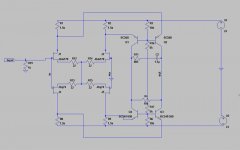Hi,
what are the requirements to drive a riaa network properly?
I have the feeling that C2/R11 are not driven properly, but how can I make sure what's approriate?
The question is both technically (the amount of current, voltage swing and so on) and sonically (what does sound good according to your experience)
Yes, there are only the lower two time constants in my example.
Rüdiger
what are the requirements to drive a riaa network properly?
I have the feeling that C2/R11 are not driven properly, but how can I make sure what's approriate?
The question is both technically (the amount of current, voltage swing and so on) and sonically (what does sound good according to your experience)
Yes, there are only the lower two time constants in my example.
Rüdiger
Attachments
To narrow my question: if I have to take into account this formula:
Ic = C*(dV/dt)
then, at a frequency of 20kHz and a voltage swing at the output of 4V, with the shown cap of 1.1µF, I'd need a current of around 88mA, so my output stage is way too shy. Is this reasoning correct?
Rüdiger
Ic = C*(dV/dt)
then, at a frequency of 20kHz and a voltage swing at the output of 4V, with the shown cap of 1.1µF, I'd need a current of around 88mA, so my output stage is way too shy. Is this reasoning correct?
Rüdiger
Yes, which is why you would not want to do it this way.
Your circuit has a high output impedance, and as I understand it, the effective gain depends on the load impedance. But this is nasty property, as it means the frequency response will depend heavily on loading by subsequent stages.
If you did want to stick with your approach, you are going to have to raise the impedance a lot - for example, you could raise R4 and R11 by a factor of 10, and cut C2 by the same factor.
You also face a fundamental difficulty, in that when you add the third time constant (presumably by adding a capacitor across R11), the maximum output swing will drop proportionally to frequency - or equivalently, the input overload level becomes frequency independent.
This may or may not be a problem - I seem to remember that maximum trackable velocities tend to fall with frequency above say 5 or 8kHz. So if you have enough overload margin to handle say 100cm/s at the stylus (more than anything ever made can track), you might be OK.
Your circuit has a high output impedance, and as I understand it, the effective gain depends on the load impedance. But this is nasty property, as it means the frequency response will depend heavily on loading by subsequent stages.
If you did want to stick with your approach, you are going to have to raise the impedance a lot - for example, you could raise R4 and R11 by a factor of 10, and cut C2 by the same factor.
You also face a fundamental difficulty, in that when you add the third time constant (presumably by adding a capacitor across R11), the maximum output swing will drop proportionally to frequency - or equivalently, the input overload level becomes frequency independent.
This may or may not be a problem - I seem to remember that maximum trackable velocities tend to fall with frequency above say 5 or 8kHz. So if you have enough overload margin to handle say 100cm/s at the stylus (more than anything ever made can track), you might be OK.
- Status
- Not open for further replies.
